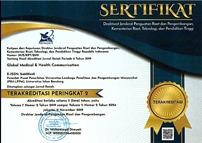Perception of Acupuncture Compared with Biomedicine among Health Practitioners
Abstract
Compared with biomedicine held by medical experts, perspectives on acupuncture may impact how the general populace uses acupuncture. Therefore, research on the opinions of medical professionals regarding acupuncture therapy is crucial. This cross-sectional study was conducted from July to September 2022 using a questionnaire. The study participants are doctors and nurses from three clinics in Bali province who had at least one year of working experience and were willing to be research respondents. Descriptive analysis and multiple logistic regression are used to determine the participants' perceptions and predictors of their perception. Of 155 participants, the majority (64%) have a positive perception of acupuncture compared with biomedicine. Participants with prior acupuncture usage were 9.01 times more likely than those without previous acupuncture use to have positive perceptions of acupuncture compared to biomedicine (Adj OR=9.01; 95% CI; p=0.001). The results of this study show that acupuncture is seen positively by health practitioners as an effective modality, has few side effects, and is supported by science. Health practitioners' perceptions are affected by their prior acupuncture experience. It is crucial to understand how medical professionals feel about acupuncture. Medical professionals' opinion impacts every patient's decision to seek therapy because one of their duties as specialists is to offer patients clinical judgment, information, and suggestions.
Keywords
Full Text:
PDFReferences
Silver Highfield E, Longacre M, Chuang YH, Burgess JF Jr. Does acupuncture treatment affect utilization of other hospital services at an urban safety-net hospital? J Altern Complement Med. 2016;22(4):323–7.
World Health Organization. Acupuncture: review and analysis of reports on controlled clinical trials. Geneva: World Health Organization; 2002.
Widowati R, Murti B, Pamungkasari EP. Efektivitas terapi akupunktur dan inframerah dalam menurunkan nyeri muskuloskeletal pada lanjut usia. IJM. 2017;2(1):41–51.
Feng S, Han M, Fan Y, Yang G, Liao Z, Liao W, et al. Acupuncture for the treatment of allergic rhinitis: a systematic review and meta-analysis. Am J Rhinol Allergy. 2015;29(1):57–62.
Zhou J, Fang L, Wu WY, He F, Zhang XL, Zhou X, et al. The effect of acupuncture on chemotherapy-associated gastrointestinal symptoms in gastric cancer. Curr Oncol. 2017;24(1):e1–5.
Landgren K, Hallström I. Effect of minimal acupuncture for infantile colic: a multicentre, three-armed, single-blind, randomized controlled trial (ACU-COL). Acupunct Med. 2017;35(3):171–9.
MacPherson H, Vickers A, Bland M, Torgerson D, Corbett M, Spackman E, et al. Acupuncture for chronic pain and depression in primary care: a programme of research. Southampton (UK): NIHR Journals Library; 2017.
García-Escamilla E, Rodríguez-Martín B. What can acupuncture bring to western medicine? The perspective of health professionals also trained in traditional Chinese medicine-based acupuncture. Eur J Integr Med. 2017;12:108–16.
García-Escamilla E, Rodríguez-Martín B, Martínez-Vizcaíno V. Integration of acupuncture into conventional medicine from health professionals’ perspective: a thematic synthesis of qualitative studies. Health (London). 2016;20(2):176–200.
Zhang NM, Vesty G, Zheng Z. Healthcare professionals’ attitudes to integration of acupuncture in western medicine: a mixed-method systematic review. Pain Manag Nurs. 2021;22(6):684–93.
Chan K, Tsang L, Fung TKF. Attitudes toward acupuncture in Hong Kong. Int J Pharm Healthc Mark. 2015;9(2):158–74.
Lu L, Zhang Y, Ge S, Wen H, Tang X, Zeng JC, et al. Evidence mapping and overview of systematic reviews of the effects of acupuncture therapies. BMJ Open. 2022;12(6):e056803.
Lu L, Zhang Y, Tang X, Ge S, Wen H, Zeng J, et al. Evidence on acupuncture therapies is underused in clinical practice and health policy. BMJ. 2022;376: e067475.
Wijanto C, Tamtomo D, Joebagyo H. Recognizing acupuncture therapist and services. J Health Policy Manag. 2019;4(2):128–38.
Mortara L, Coco G, Pozzi C. Biomedicine and traditional Chinese medicine: a fruitful scientific and cultural interaction. Acta Biomed. 2022;93(1):e2022070.
Zhang N, Houle T, Hindiyeh N, Aurora SK. Systematic review: acupuncture vs standard pharmacological therapy for migraine prevention. Headache. 2020;60(2):309–17.
Toroski M, Nikfar S, Mojahedian MM, Ayati MH. Comparison of the cost-utility analysis of electroacupuncture and nonsteroidal antiinflammatory drugs in the treatment of chronic low back pain. J Acupunct Meridian Stud. 2018;11(2):62–6.
Dananjaya R, Wisaksana R, Sudjana P, Iskandar S. Perception of health workers on preventing COVID-19 transmission behavior based on work area and exposure. GMHC. 2022;10(2):144–51.
Chan K, Siu JYM, Fung TK. Perception of acupuncture among users and nonusers. Health Mark Q. 2016;33(1):78–93.
Patel A, Chen Y. Patients’ reasons for seeking traditional Chinese medicine: a qualitative study. J Prim Health Care. 2018;10(4):338–42.
Patel A, Toossi V. Traditional Chinese medicine practitioners in New Zealand: differences associated with being a practitioner in New Zealand compared to China. N Z Med J. 2016;129(1444):35–42.
Witt CM, Schützler L, Lüdtke R, Wegscheider K, Willich SN. Patient characteristics and variation in treatment outcomes which patients benefit most from acupuncture for chronic pain? Clin J Pain. 2011;27(6):550–5.
DOI: https://doi.org/10.29313/gmhc.v11i2.11369
pISSN 2301-9123 | eISSN 2460-5441
Visitor since 19 October 2016:
Global Medical and Health Communication is licensed under a Creative Commons Attribution-NonCommercial-ShareAlike 4.0 International License.































.png)
_(1).png)
_(1).jpg)
